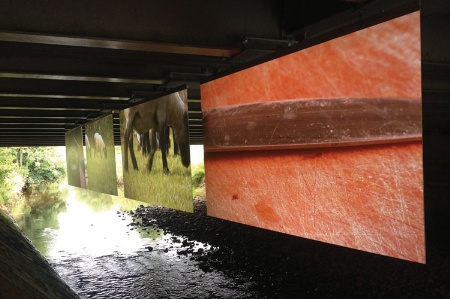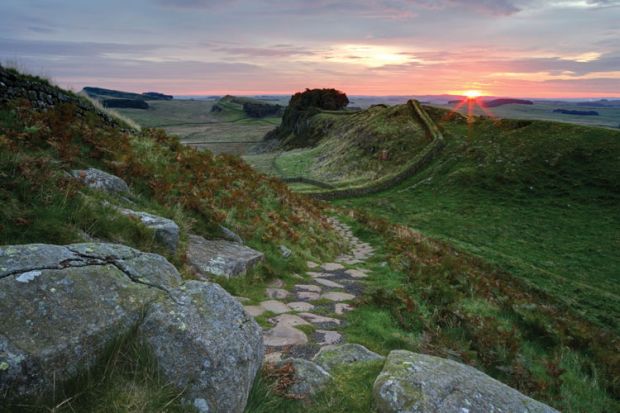Source: Alamy
To think positively about the future for this region requires what has been termed a ‘place-based co-operation’, not competition or contested spaces
The run-up to the Scottish referendum on 18 September has been the cause of particular reflection for many in the English-Scottish border region. Will a Scottish “yes” vote mean yet greater isolation from, and even further neglect by, London and the South East of the North of England? Will the comparisons of the North East to an economically stricken Detroit, aired recently in a much-criticised Guardian article, ultimately be justified – with, for example, businesses moving away to take advantage of lower rates of corporation tax across the border? Or might Scottish independence prompt measures for greater connectivity across the entire northern part of the British Isles, foster greater sharing of resources and encourage a stronger, more resilient local and regional economy?
Whatever the actual outcome on the 18th, many already seem to recognise a deeper consciousness of identity and belonging, culture and heritage in the border region. The issue struck home for me when I heard an English holidaymaker on the beach at Broadstairs in Kent give her opinion in Andrew Neil’s documentary on the Scottish vote. The question was of no consequence: “They’re not the same as us anyway, so let them have their independence.” It was a throwaway remark for the camera, and all the more revealing for that perhaps, but for those of us “up north” yet just below the border, it was especially ludicrous, and underlined how deeply and endlessly problematic this notion of identity and national belonging is.
To grow up or to live for any time in the English-Scottish border region is to take as self-evident the impossibility of any notion of fixed national identity. It is to be ever aware of the continual fluidity of movement here at the margins, both historically and in the experience of everyday life, despite the abrupt changes in accent and differences in governance on crossing the River Sark. As someone brought up on the English West Marches in a house built in the 1600s out of stones pinched from nearby Hadrian’s Wall, but with a maternal Border Reiver ancestry that stretches across the Debatable Lands into Scotland, the concept of cross-border identities and of “Borderers” is a given.
We all recognise that communication networks forge cultural affiliations for groups and individuals who are not neatly defined by geographical boundaries. In my own growing up, some of this was achieved by the Border Television franchise that stretched across most of Cumbria, the Scottish Borders, Dumfries and Galloway to the Isle of Man, reporting nightly on news and local affairs. All this helped to shape or reinforce a genuinely cross-border community, to the extent that many in Cumbria would claim closer affinity with their Scottish neighbours than with their English ones to the east. The question of felt identities in relation to place, borders and boundaries, real or imagined, permeable or enforced, has a very particular resonance here.
The English-Scottish border region has had a long history as a militarised zone ever since the construction of Hadrian’s Wall from AD122, throughout 300 years of reiving and still today, in the nearby 9,000 acres of north-west Cumbrian bog and moorland at RAF Spadeadam. In the late 1950s and early 1960s, the area was a Cold War testing site for Blue Streak, a never-realised medium-range ballistic missile, and is now an Electronic Warfare Tactics Range. The overlayering of history, memory, local and global interactions evidenced throughout the centuries has attracted the attention of many, including artists such as Louise K. Wilson, who in 2002 documented the ruins and remains of the Blue Streak venture, now listed by English Heritage.

Over to the east, another heavily fortified and long-contested space is the English town of Berwick-upon-Tweed, currently a focus for debate over independence and regional and national identities. In the same week as the referendum, the 10th Berwick Film and Media Arts Festival will be held, with the appropriate theme of “Border Crossing”. Showing there will be Tweed-Sark Cinema, a commissioned installation by Dumfries and Galloway-born film-maker and video artist John Wallace, which offers a fascinating and entirely productive way of conceptualising the region.
Sited in a former icehouse on the banks of the river, Tweed-Sark Cinema is an audiovisual study of human relationships with the ecosystems of the two rivers they inhabit and rely upon – the Sark in the west and the Tweed in the east, which mark the English-Scottish border. Produced in collaboration with Pete Smith, professor of soils and global change at the University of Aberdeen, the work developed out of Cinema Sark, which was installed beneath the A74(M) Sark Bridge at Gretna as part of the 2013 Environmental Arts Festival.
Found sound, commissioned music, archival material and contemporary footage, including interviews with some of those “who live and work along the catchments of the Sark and Tweed from their headwaters in the Eskdale and Moffat hills to the Solway Estuary and the North Sea”, are synchronised across four screens. Environmental sensors placed along the river catchments capture live data that the video and audio tracks respond to.
The project as a whole is inspired by the concept of ecosystem services modelling. This identifies the dynamic relationships that exist between the production and consumption of resources, including soil formation and freshwater systems, energy generation, agriculture, fisheries, water regulation, noise pollution and even cultural practices such as recreation and heritage. References to all these appear within the images presented on the four video screens and the accompanying audio track.
As Wallace explains, “The River Sark doesn’t know it’s a border.” His installation was not intended as a direct statement about the current independence debates. Nonetheless, in its emphasis on the inextricable connectivity between processes of growth and decay, the ebb and flow of seasonal change, and the rhythms of daily lives on either side of the rivers’ banks, it underlines the fact that the border region is indeed a dynamic and hybrid place. It follows, then, that to think positively about the future for this region requires what has been termed a “place-based co-operation”, not competition or contested spaces. We need to adopt new ways of inhabiting the “borderlands” and perhaps of practising “borderliness”.
Across its four screens, Wallace’s creative framing of the environment of the English-Scottish border offers clear links with the larger focus of two current research projects associated with Northumbria University.
Keith Shaw’s contribution to an Economic and Social Research Council project – Close Friends? Assessing the Impact of Greater Scottish Autonomy on the North of England – has produced a series of recommendations aimed at fostering greater opportunities for cross-border and east-west collaborations in sectors of mutual concern, such as transport, energy, tourism, rural development, education and skills. My own contribution to an interdisciplinary Arts and Humanities Research Council research network – Northern Peripheries – has focused on rethinking habitual perceptions and cultural representations of border regions as marginal spaces, proposing that the northern peripheries should be seen as generative locations where diverse networks can and do develop. Whatever the result later this month, the fundamental question has to be: what next?
Register to continue
Why register?
- Registration is free and only takes a moment
- Once registered, you can read 3 articles a month
- Sign up for our newsletter
Subscribe
Or subscribe for unlimited access to:
- Unlimited access to news, views, insights & reviews
- Digital editions
- Digital access to THE’s university and college rankings analysis
Already registered or a current subscriber? Login

